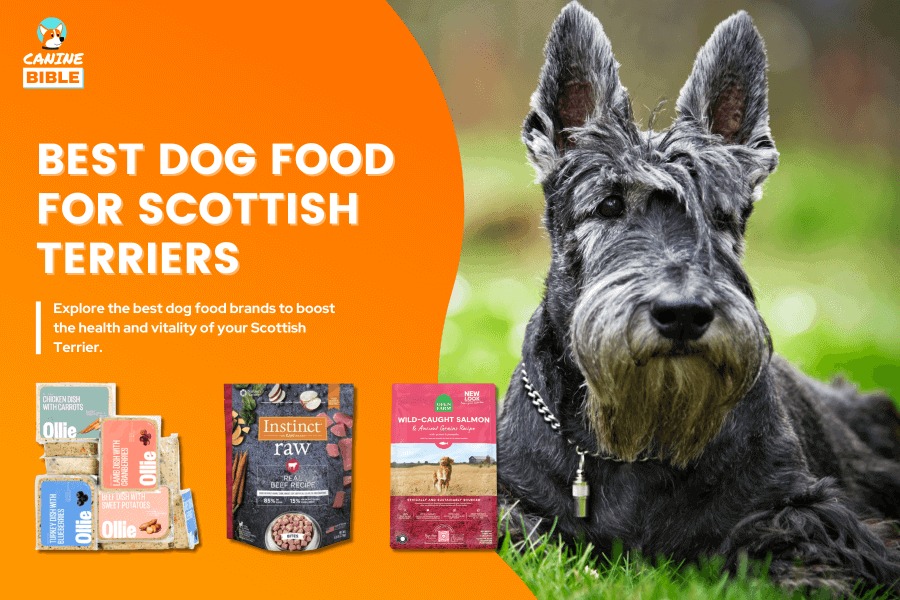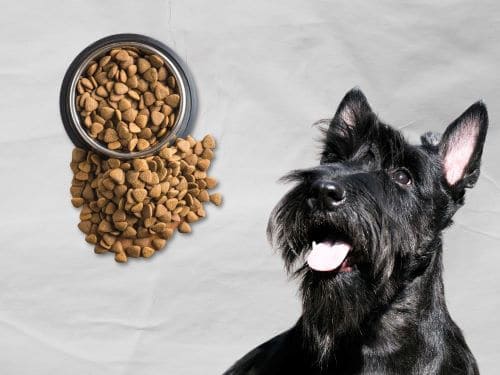
Ahoy, dog lovers! Yours truly, the resident pet caretaker extraordinaire, is here to spill the beans on how to ensure your furry, feisty Scottish Terrier gets the best possible grub. Let’s embark on this tasty adventure and uncover the secrets of pawfect nutrition!

A Breed Apart: The Scottish Terrier Dietary Needs
First things first, let’s address the elephant in the room: Scottish Terriers are a breed apart, both in their lively personalities and their dietary requirements. These tenacious little rascals were originally bred to hunt vermin on farms, so they’re used to an active lifestyle and need a diet that can keep up with their boundless energy.
Digging into the Ingredients: What’s on the Menu?
When it comes to selecting the best chow for your Scottie, it’s crucial to understand the key ingredients that should grace their food bowl. Here’s a quick rundown of the essentials:
- Protein Power: Lean meats like chicken, turkey, or fish should be the primary protein source, ensuring your furry friend gets the amino acids they need for strong muscles and a healthy coat.
- Carb Loading (in Moderation): Complex carbohydrates from whole grains, veggies, and legumes provide the energy boost your Scottie needs for their daily shenanigans. Just don’t overdo it, or you might end up with a rotund Terrier on your hands!
- Fatty Acids for Fabulous Fur: Omega-3 and omega-6 fatty acids from sources like fish oil and flaxseed help maintain that lustrous coat and keep their skin in tip-top shape.
- Vitamin Variety: A well-rounded mix of vitamins and minerals ensures your pup stays in peak condition, from their bouncy gait to their sparkling eyes.
Dry vs. Wet: The Great Debate
Now, let’s address the age-old quandary: dry or wet food? Truthfully, both options have their pros and cons, so it’s a matter of finding the right balance for your Scottie’s needs and preferences.
Dry kibble is often more convenient and can help keep their teeth clean, but it’s important to ensure they’re getting enough moisture from other sources. Wet food, on the other hand, can be more appetizing and hydrating, but it can also be messier and less cost-effective in the long run.
Reading the Fine Print: Decoding Dog Food Labels
Navigating the sea of dog food brands and labels can be overwhelming, but fear not! Here are some handy tips for deciphering the fine print:
- Ingredient List: The ingredients should be listed in order of weight, so you’ll want to see real, recognizable protein sources like “chicken” or “salmon” at the top of the list, not vague terms like “meat by-products.”
- Nutritional Adequacy Statement: Look for a statement confirming that the food meets the nutritional requirements set by the Association of American Feed Control Officials (AAFCO) for your dog’s life stage.
- Expiration Date: Always check the “best by” or expiration date to ensure the food is fresh and hasn’t been sitting on the shelf for too long.
Portion Control: Finding the Goldilocks Zone
Even with the best food in the world, overfeeding can lead to unwanted weight gain and health issues. The key is to find the “Goldilocks zone” – not too much, not too little, but just the right amount for your Scottish Terrier’s age, activity level, and metabolism.
As a general guideline, adult Scottish Terriers typically need between 1/2 to 1 cup of high-quality dry food per day, divided into two meals. But every pup is unique, so it’s best to consult with your vet or follow the feeding guidelines on the food label and adjust as needed based on your Scottie’s body condition.
Treats and Snacks: Moderation is the Spice of Life
Let’s be real, we all love to spoil our fur babies with treats and snacks. But remember, these should be given in moderation and accounted for as part of their overall daily calorie intake. Look for healthy, low-calorie options like fresh veggies, lean meats, or specialized dog treats made with wholesome ingredients.
Keeping Hydration in Check: Agua, Agua, Everywhere!
Don’t forget about the importance of fresh, clean water! Scottish Terriers are prone to dehydration, especially during warm weather or after strenuous activities. Make sure to provide your pup with a constant supply of cool, refreshing H2O and encourage them to drink regularly.

Conclusion
Well, there you have it, folks! By following these guidelines and choosing a high-quality, balanced diet tailored to your Scottish Terrier’s needs, you’ll be well on your way to ensuring your furry companion stays healthy, happy, and full of that signature Scottie spunk. Remember, a well-fed pup is a well-behaved pup (or at least, that’s what we like to tell ourselves!).
FAQs
- Can Scottish Terriers eat raw food diets? While some dog owners swear by raw food diets, it’s important to consult with your veterinarian first to ensure it’s appropriate for your Scottish Terrier’s individual needs and that you’re following proper food handling and safety protocols.
- Are Scottish Terriers prone to food allergies? Like many breeds, Scottish Terriers can be prone to food allergies or sensitivities, especially to common ingredients like beef, dairy, or wheat. If you notice any adverse reactions, consult your vet and consider trying a limited-ingredient or hypoallergenic diet.
- Can Scottish Terriers eat human food? While some human foods can be given as occasional treats (like plain, cooked chicken or vegetables), it’s generally best to stick to a balanced, complete dog food formulated specifically for your Scottie’s nutritional needs. Many human foods can be unhealthy or even dangerous for dogs.
- How often should I switch my Scottish Terrier’s food? Unless your pup has specific dietary requirements or you’re introducing a new food gradually, there’s no need to constantly switch up their food. Consistency is key when it comes to their diet, as frequent changes can lead to digestive upset or picky eating habits.
- Can Scottish Terriers be vegetarians or vegans? While some dog owners choose to feed their pups vegetarian or vegan diets, it’s generally not recommended for Scottish Terriers. As a breed, they tend to thrive best on a diet that includes high-quality animal-based proteins and other nutrients that can be difficult to obtain from plant sources alone.






